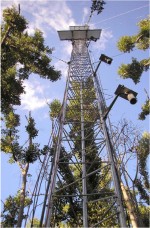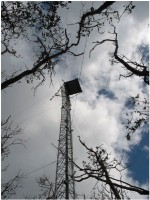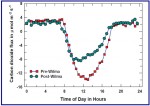FCE study on carbon sequestration by mangrove forests in the southwest Florida Everglades
In October 2005, hurricane Wilma severely disrupted the Florida Everglades ecosystem. Fringing mangrove forests exposed to hurricane-level winds were effectively destroyed, while more sheltered forests were severely damaged. At the FCE-LTER flux tower site (SRS-6), about a third of the trees were destroyed and roughly 3 cm of carbonate mud added on the mangrove forest floor. All instruments on the flux tower were also destroyed (Figure 1) and the tower itself damaged beyond repair and had to be replaced. The boardwalks and supporting structures also had to be re-built.
The reconstruction of the flux tower was completed in October 2006 (Figure 2) and comparisons between pre- and post-hurricane ecosystem response and function are now possible. Despite its destruction, hurricane Wilma and the "fortuitous" location of the tower provided us a rare opportunity to investigate the responses of mangrove forests to disturbances. For example, we can now quantify changes in the carbon dioxide (CO2) exchanges between the mangrove forest canopy and the atmosphere before and after the hurricane. Figure 3 illustrates the results of analyses with pre- and post-hurricane data. It is evident from the results that during the day the mangrove forest assimilates CO2 at much lower rates than before the hurricane. The reduced CO2 assimilation is likely linked to the decrease in active biomass within the forest canopy. The respiration rates before and after the hurricane are currently similar but are expected to increase in the future as the biomass introduced by hurricane Wilma decomposes.
In addition to re-starting the carbon flux measurements, after Wilma additional projects were initiated to study transpiration rates, soil water content, and other components of the local hydrologic cycle. These field investigations are adding new knowledge to develop an improved understanding of disturbance effects on ecosystem responses and functioning along the interface between water and land. The studies are contributing to our basic understanding of how coastal ecosystems function while recovering from large-scale disturbances. They may also shed light on the effects of similar large-scale anthropogenic influences, such as global climate change and sea level rise. This research will also provide information needed for the development of process-based numerical models to help predict ecosystem functioning under the influences of regional and global environmental changes.

 Enlarge this image
Enlarge this image

